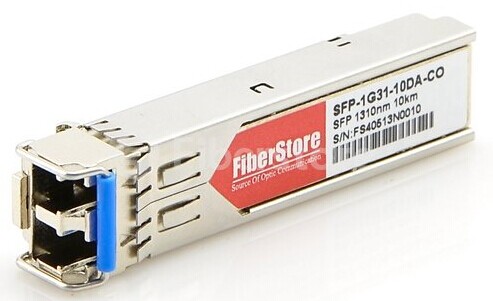Common Types of Fiber Optic Transceivers
Fiber optic transceivers are devices that both transmit and receive data. Fiber optic transceiver is typically used in computer networks to translate signals between optical and electric networks. In other words, the sending side of it transfers the electrical signals into optical signals, and then transmitted by the fiber, the receiving side transfers the optical signals into electrical signals. This article will introduce the common types of fiber optic transceivers on the market.
SFP is short for Small Form-factor Pluggables, unlike GBIC transceiver with SC fiber optic interfaces is with LC interface and the main body size of SFP is only about half of GBIC, which makes SFP space saving. SFP transceiver module is a compact, hot-pluggable transceiver used for both telecommunication and data communications applications. SFP modules are commonly available in several different categories:850nm 550m multi-mode fiber (SX), 1310nm 10km single-mode fiber (LX), 1490nm 10km single-mode fiber (BS-D), 1550nm 40km (XD), 80 km (ZX), 120 km (EX or EZX), 1490nm 1310nm (BX), single fiber bi-directional gigabit SFP transceivers, copper SFP with RJ45 connector, CWDM SFPs, DWDM SFPs, SGMII SFPs, etc. The following Cisco GLC-LH-SMD compatible 1000BASE-LX/LH SFP transceiver provided by Fiberstore is high performance and cost-effective module operating at the wavelength of 1310nm and supporting 10km transmission distance over single-mode fiber.

As its name suggests, SFP+ transceiver module (small form-factor pluggable plus) is an upgraded version of the SFP transceiver module that supports data rates up to 10Gbit/s. SFP+ transceiver modules are with lower power consumption for less than 1W and it is even cost effective. These optical transceivers are with managed digital optical monitoring and superior high temperature performance. SFP+ supports 8 Gbit/s Fiber Channel, 10 Gigabit Ethernet and Optical Transport Network standard OTU2. It is a popular industry format supported by many network component vendors. In comparison to earlier XENPAK or XFP module, SFP+ module is with more compact size and measurement, leave more circuitry to be implemented on the host board instead of inside the module. Consideration has to be given to whether the module is linear or limiting. Linear SFP+ modules are most appropriate for 10GBASE-LRM; otherwise, limiting modules are preferred.
XFP are standardized 10GBASE hot-swappable and protocol-independent modules. They typically operate at optical wavelengths of 850 nm, 1310 nm or 1550 nm. Principal applications include 10 Gigabit Ethernet, 10 Gbit/s Fiber Channel, Synchronous optical networking (SONET) at OC-192 rates, Synchronous optical networking STM-64, 10 Gbit/s Optical Transport Network (OTN) OTU-2, and parallel optics links. They can operate over a single wavelength or use DWDM techniques. XFP modules use an LC fiber connector type to achieve high density. XFP modules are commonly available in several different categories: SR - 850 nm, for a maximum of 300 m, LR - 1310 nm, for distances up to 10 km, ER - 1550 nm, for distances up to 40 km, ZR - 1550 nm, for distances up to 80 km. The XFP packaging was smaller than the XENPAK form-factor.
QSFP+ interfaces a network device motherboard (for a switch, router, media converter or similar device) to a fiber optic cable. It is an industry format jointly developed and supported by many network component vendors, supporting data rates from 4x10 Gbit/s. The QSFP+ transceiver supports Ethernet, Fiber Channel, InfiniBand and SONET/SDH standards with different data rate options. For example, HP JG709A compatible QSFP+ transceiver from Fiberstore supports link lengths of 300m over multimode fibers, at a wavelength of 850nm. It primarily enables high-bandwidth 40G optical links over 12-fiber parallel fiber terminated with MPO multifiber connectors and can also be used in a 4x10G module for interoperability with 10GBASE-SR interfaces.
CFP is a multi-source agreement to produce a common form-factor for the transmission of high-speed digital signals. The "C" stands for the Latin letter C used to express the number 100 (centum), since the standard was primarily developed for 100 Gigabit Ethernet systems. The CFP was designed after the SFP interface, but is significantly larger to support 100 Gbit/s. CFP transceiver supports a wide range of 40 and 100 Gb/s applications such as 40G and 100G Ethernet, OC-768/STM-256, OTU3, and OTU4. Different versions of CFP modules can support various link distances over either multimode or single mode fiber optics. The CFP module includes numerous innovative features like advanced thermal management, EMI management and enhanced signal integrity design, as well as an MDIO-based management interface.
Fiberstore provides a full range of optical transceivers, such as SFP+ (SFP Plus) transceiver, X2 transceiver, XENPAK transceiver, XFP transceiver, SFP (Mini GBIC) transceiver, GBIC transceiver, CWDM/DWDM transceiver, 40G QSFP+ & CFP, 3G-SDI video SFP, WDM Bi-Directional transceiver and PON transceiver. All these fiber optic transceivers are 100% compatible with major brands like Cisco, HP, Juniper, Nortel, Force10, D-link, 3Com. They are backed by a lifetime warranty, and you can buy with confidence. We also can customize optical transceivers to fit your specific requirements.